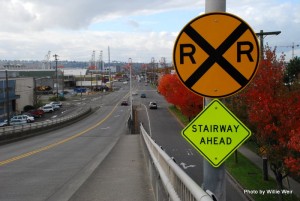
(This article is cross-posted, with permission, from the blog Yellow Tent Adventures. — Ed.)
Recently ribbons were cut and speeches were made at the opening of the new segment of the Mountains-to-Sound Trail. Any additional trail miles that provide needed access for bikes and pedestrians is cause for celebration. Except that the Mountains-to-Sound Trail now officially ends at a blind corner of a very steep hill.
Holgate, which rises to and descends from Beacon Hill, is legendary on this side of the city. It is the type of road that even some seasoned cyclists choose to avoid. If you are descending it from the top of Beacon Hill, you can easily hit 40mph without a single pedal stroke. You just take the lane and fly. The road crosses I-5, and at this point as a cyclist, you need to be hyper-aware as you dump out onto the left lane of traffic. Cars turning from Airport Way S. are speeding to make the light at 6th Ave. S. Many motorists like to make a left hand turn across your path as they exit the Office Depot. And the road surface is a photo op for the “repave our streets†campaign.
On the way up Holgate you are in a narrow lane with a high curb on your right as you climb over I-5. The thought that a car clipping you could send you catapulting onto the freeway is enough to have many cyclists choose to ride on the left hand sidewalk and then cross over at the blind corner as the sidewalk ends. Sounds fun, doesn’t it?
Can you imagine parents riding their bikes along with their two young kids tackling any or all of this? It sounds rather nightmarish.
And yet it is a possibility. The Mountains-to-Sound Trail is a separated recreational path. The type of trail that is desirable for riders and walkers who aren’t comfortable in traffic. The recently opened extension expands the trail from 12th Ave. S. to Holgate. The path is a delight and offers beautiful vistas of downtown Seattle. I had a hard time wiping the grin off my face the first time I rode it.

What is the family with their two kids going to do? They’ll look at the option of crossing the road at the blind intersection and climbing the steep hill to their left. But what’s up there? They don’t know, because they are visiting from Spokane or Missoula and they don’t know that at the top is the business district of Beacon Hill with a light rail station, bus connections, stores, restaurants, a library, and a huge park. No, to them it’s just a big scary hill to destinations unknown.
Then they’ll look down the hill and think, “The Sound is that way.†They’ll opt to walk their bikes down the sidewalk because the hill is steep and their kids are scared. This is good. Because that sidewalk ends in a flight of stairs. To their credit, SDOT has posted a sign regarding this about 200 feet before impact.

But I’m guessing at this point our family will opt to turn around and push their bikes back up the sidewalk. The kids will be crying and Mom and Dad will think, “This is unsafe and crazy.†They will finally reach the trail and backtrack from whence they came.
What the family doesn’t know is that the Mountains-to-Sound Trail will eventually be completed. There will be a switchback trail that crosses under the freeway and connects to the bike trail and light rail station at Royal Brougham. But construction of that section isn’t even scheduled yet… so it’s years away.
In the meantime, information needs to be posted that gives everyone an option. Experienced city traffic cyclists can take a right at Holgate and shoot into the Sodo District or take a cautious left and climb to the Beacon Hill business district. Others can backtrack and follow the bike route signs to downtown, or be routed that way to begin with.
The dangerous conditions at the blind curve where Holgate becomes Beacon Ave. S. need to be addressed. This is now more important than ever! This is one of the few accessible routes up to Beacon Hill and it should be made safe for everyone.
The Mountain-to-Sound Trail extension is great! It will be better when it is finished (South Seattle’s missing link?). But until then, we need signage that explains the current conditions, and improvements that give everyone safe options. Without them, the ride doesn’t end well.



